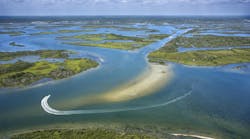About the author: Rebecca Wilhelm is associate editor for Storm Water Solutions. Wilhelm can be reached at 847.954.7958 or by e-mail at [email protected].
The Albuquerque Metropolitan Arroyo Flood Control Authority (AMAFCA), formed by the New Mexico Legislature in 1963, has close to 400 sq miles of drainage area under its jurisdiction. AMAFCA owns and operates more than $150 million worth of flood control facilities comprised of 34 flood control dams, 65 miles of arroyo channels, nine miles of underground facilities and six miles of dikes and diversion structures.
The authority controls more than 4,000 acres within its boundaries, much of which is available for joint use as open space, bike trails, recreational fields and wildlife habitat. AMAFCA’s extensive system of drainage channels captures runoff and ultimately discharges it into the Rio Grande River.
“AMAFCA has done numerous water quality projects, including trash racks, ported outlet structures at dams, weir structures, water quality manholes and a number of screen-type structures,” said Kurt Wagener, P.E., AMAFCA field engineer. “Much of this is part of our MS4 permit, but also it’s because the AMAFCA Board of Directors understands that whenever we can clean up water, it will keep the Rio Grande cleaner.”
Improving the Pino Arroyo
An existing water quality feature on the North Pino Channel was designed to pull about 80 cu ft per second (cfs) out of the bottom of the channel through a 48-in. reinforced concrete pipe, run it through a weir structure and drop floatables and sediment out of the water. The cleaned water then went to a water quality pond.
“This worked pretty well in cleaning the ‘first-flush’ floatables, trash, sediment and debris,” Wagener said. “AMAFCA did find that some of the floatables were being pulled through the weir. The weir was raised to help this, but floatables were still being sucked through.”
At the 2006 StormCon conference in Denver, Jerry Lovato, P.E., AMAFCA drainage engineer, stopped at the booth of Hydroscreen Co. LLC and saw an active hydraulic model of the company’s curb inlet filtering device.
“Jerry was impressed with the wedge-wire screen demonstration,” Wagener said. Being a little skeptical, Lovato went outside the hall and got a handful of dirt to see if it would be filtered off of the screen.
When Lovato came back from the conference with the screen idea, John Kelly, P.E., AMAFCA executive engineer, decided to modify the North Pino structure again using the wedge-wire screen.
Implementation
The device utilizes a tilted-wire wedge-wire screen to capture coarse sediment and debris. This technology has a long history in liquid solids separation in the coal and hydropower industries but has gained slower acceptance in storm water cleanup, according to Robert K. Weir, P.E., founder of Hydroscreen.
The tilted-wire wedge-wire screen is made up of many triangle-shaped wires that are tilted and welded onto support bars, forming a surface similar to a file, where each wire shears a layer of water. The debris does not follow the water through the screen but continues down the face of the screen until it has no more water to carry it or it goes off the toe of the screen.
The screen is self-cleaning and does not need regular maintenance, making it an attractive alternative for AMAFCA. The removed debris is collected periodically by a small skid loader and moved to a landfill.
After an initial feasibility study, the agency hired a consultant to do the basic structural and hydraulic design with input from Hydroscreen engineers, Weir said. The screens were ultimately sized to pass a flow of 90 cfs and remove all debris and sediment larger than 500 microns. A good portion of the structure was already in place, so only a toe wall was needed.
The screens were shipped in 5-ft-wide sections that were attached to the acceleration and toe plate. Total installation took less than a day to complete.
The only problem encountered with the screens arose when thieves removed and sold them as scrap metal at a local junkyard. “We recovered the screens and have since done a security installation, which included tack welding bolts and connections,” Wagener said.
Looking Ahead
Based on their experience at Pino Arroyo, AMAFCA also installed a 400-cfs unit on the larger Vineyard Arroyo. This location was designed to accommodate 11 ft of head on the screen.
“The screen structures both have performed well,” Wagener said. “Albuquerque doesn’t get that many rain events, so when we do there is a lot of accumulated floatables, trash, debris and sediment on the streets and in the channels.”
AMAFCA’s proactive implemen-tation of emerging technology highlights their priority of keeping the Rio Grande clean and debris-free.
“AMAFCA is making a difference in storm water cleanup,” Weir said. “What they have installed is truly a best management practice.”
Author’s note: For more information, contact Robert K. Weir, P.E., of Hydroscreen. Weir can be reached at 303.333.6071 or by e-mail at [email protected].
Download: Here

